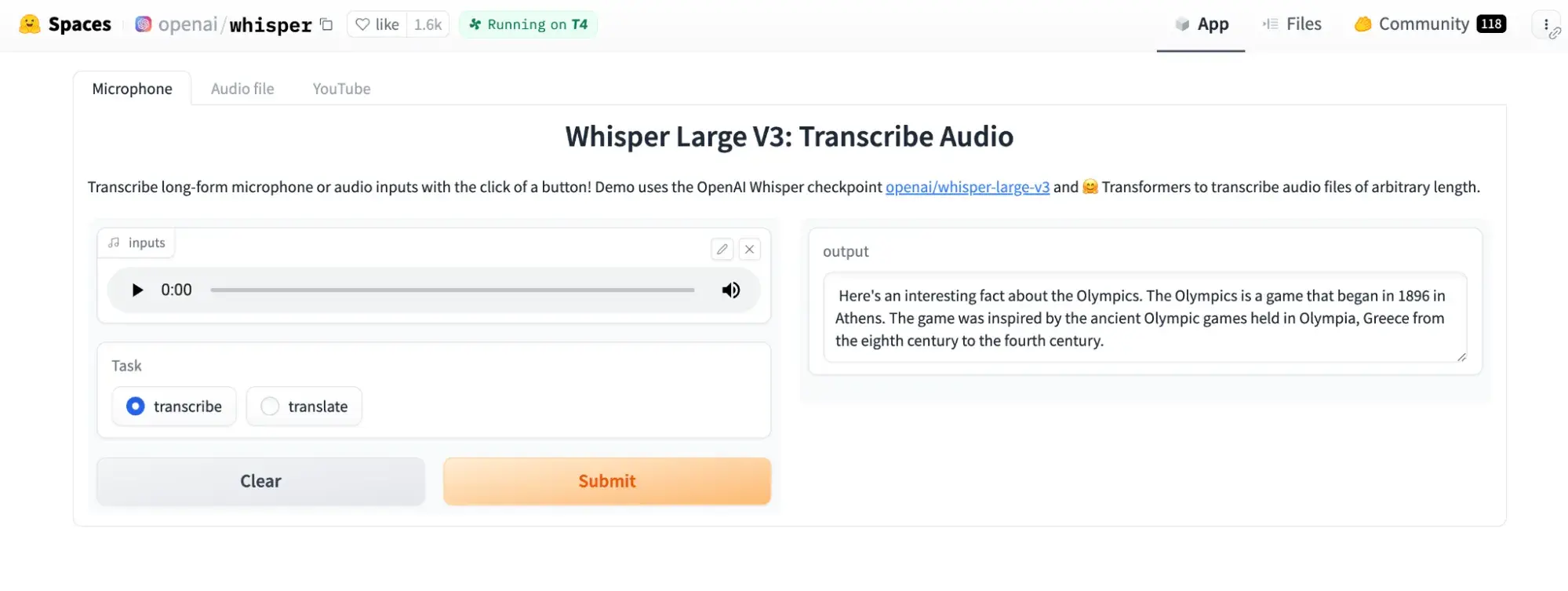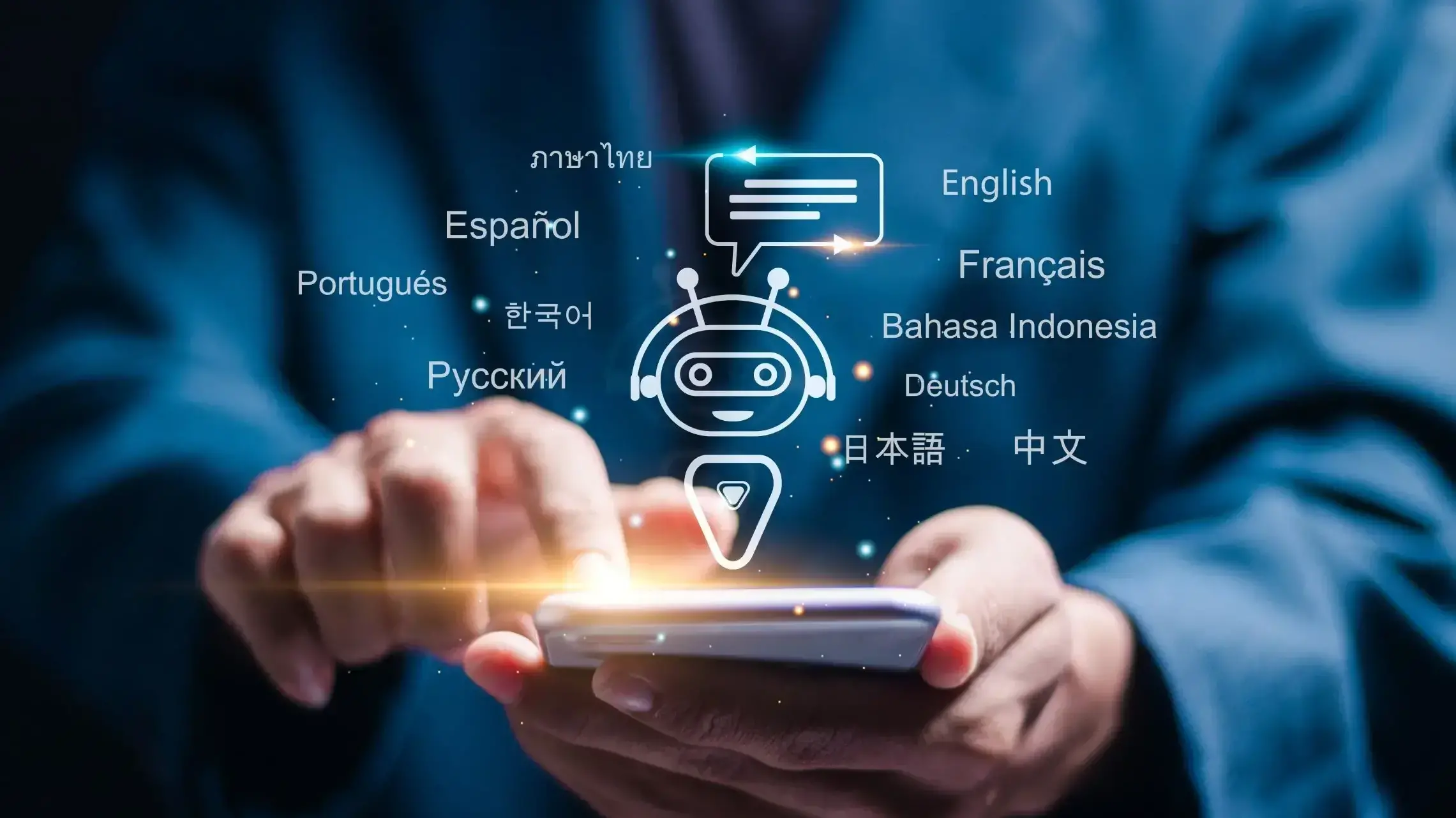Whisper, an automatic speech recognition (ASR) system, stands out with its unique features. It has been trained on a vast 680,000 hours of multilingual and multitasking supervised data collected from the web. This extensive training has improved its robustness to accents, background noise, and technical language. Whisper's unique feature is its ability to transcend language barriers, enabling transcription in multiple languages and translation from those languages into English. OpenAI has open-sourced models and inference code, providing a solid foundation for building useful applications and further research on robust speech processing with Whisper.
What is OpenAI Whisper?
Whisper is an automatic speech recognition system created by OpenAI. It is a machine-learning model for speech recognition and transcription. Whisper is open-source and free to use, distribute, and change.
Whisper, a groundbreaking innovation by OpenAI, revolutionizes speech recognition technology with unique and advanced features. Its use cases span various contexts, from enhancing accessibility to streamlining workflows and fostering innovative technology applications. This versatility makes it a powerful tool for building modern applications.
How does OpenAI Whisper Work?
OpenAI Whisper is one of the best tools for transcribing speech to text in various languages. However, how exactly does it accomplish this? OpenAI Whisper utilizes a deep learning model based on an encoder-decoder transformer architecture. A transformer can remember what was said previously to contextualize words, which helps boost their transcription accuracy.
Whenever an audio recording is fed into Whisper, it divides the audio into 30-second segments, making it easier to manage. These segments are converted into a Log-Mel spectrogram, displaying different frequencies and intensities as a heatmap over time. This spectrogram is passed through an encoder, which analyzes and compresses the key features of the audio. After the compressed information has been processed, it is passed to a decoder that converts it into text.
The decoder is trained to predict the text using special tokens to perform additional tasks such as identifying the spoken language, adding timestamps to show when each word or phrase is spoken, transcribing speech in multiple languages, and translating speech into English.

Source: OpenAI
When OpenAI Whisper encounters speech, it does not just listen passively—it actively analyzes it. It breaks down the audio into 30-second clips (think of it as breaking up the audio into batches), studies them, and then deciphers the speech by predicting the most likely transcription. Like a language prodigy, OpenAI Whisper does not stop at understanding. It learns, adapts, and improves. With each task, the system becomes better at recognizing and transcribing speech, making it more efficient and accurate. To customize the transcription process to your needs, experiment with different audio files and explore additional options from the Whisper Library.
Benefits of Using OpenAI Whisper
OpenAI Whisper is a powerful tool that can bring many advantages to your projects, regardless of size or scope.
Here are some of the benefits:
High Accuracy: OpenAI Whisper boasts that its language model has undergone extensive training using 680,000 hours of multilingual data. This results in high accuracy in transcription and translation tasks. The rigorous training has also improved the AI's robustness and ability to detect accents while eliminating background and technical noise.
Versatility: OpenAI Whisper is a versatile AI model that can be adapted to perform various tasks and understand different languages. However, it is important to note that even though it is designed to be a one-size-fits-all solution, it may not be the best choice for every task. For instance, if you have a specific task in mind, such as transcribing earnings calls or deciphering multi-person meetings, using a specifically trained or fine-tuned AI model for that particular task would be better.
Real-time Transcription: OpenAI Whisper can transcribe speech in real time, which is ideal for live events and meetings.
Fine-tuning: If you have specific needs, you can fine-tune Whisper’s models to better suit your audio. This requires more technical skill but can significantly improve results.
Practical Use-cases for OpenAI Whisper

Transcription Services: Whisper's ability to transcribe audio and video content in real-time or from recordings offers a convenient solution for generating accurate meeting notes, interviews, lectures, and any spoken content that needs to be documented in text. This empowers you to focus on the conversation.
Subtitles and Closed Captioning: Whisper's automatic generation of subtitles and closed captions for videos not only enhances accessibility for viewers who prefer text but also significantly improves the viewing experience for the deaf and hard-of-hearing community. This feature underscores OpenAI’s commitment to inclusivity and making technology accessible to all.
Language Learning and Translation: Whisper's ability to transcribe multiple languages supports language learning applications. It can help with pronunciation practice and listening comprehension. Combined with translation models, it can also facilitate real-time cross-lingual communication.
Accessibility Tools: Beyond subtitles, Whisper can be integrated into assistive technologies to help individuals with speech impairments or rely on text-based communication. It can convert spoken commands or queries into text for further processing, enhancing the usability of devices and software.
Content Searchability: Whisper allows users to search vast amounts of multimedia data by transcribing audio and video content into text. This capability is crucial for media companies, educational institutions, and legal professionals who must find specific information efficiently.
Voice-Controlled Applications: Whisper's versatility shines as it can be the backbone for developing voice-controlled applications and devices. It enables users to interact with technology through natural speech, sparking inspiration for various applications, from smart home devices to complex industrial machinery. With Whisper, the possibilities are endless, and your creativity is the only limit.
Customer Support Automation: Whisper can transcribe calls in real-time in customer service. It allows for immediate analysis and response from automated systems, which can improve response times, accuracy in handling queries, and overall customer satisfaction.
Podcasting and Journalism: For podcasters and journalists, Whisper offers a fast way to transcribe interviews and audio content for articles, blogs, and social media posts, streamlining content creation and making it accessible to a wider audience.
Transcribing Meetings and Conferences: Whisper is particularly useful in business and academic settings where meeting minutes and lecture notes are essential. Providing real-time transcription ensures no important details are missed and offers a written record for future reference.
How to Implement OpenAI Whisper in Your Project
If you want to enhance your project with advanced speech-to-text capabilities, OpenAI Whisper is an ideal solution. Integrating Whisper into your project is straightforward and can significantly improve transcription accuracy and efficiency.
The first step involves utilizing the OpenAI Whisper API, which provides access to all the powerful features Whisper offers. Once you access the API, integration into your project is the next step. While this may initially seem challenging, OpenAI provides comprehensive documentation with detailed guidelines to assist you throughout the process. The Audio API provides two speech-to-text endpoints, transcriptions and translations, based on the state-of-the-art open-source large-v2 Whisper model.
The final step is thorough testing. It is crucial to ensure that OpenAI Whisper functions correctly within your project. Conduct rigorous tests, gather feedback, and make necessary adjustments. You can seamlessly implement OpenAI Whisper, enhancing your application’s capabilities and overall performance.
Alternatively, you can test the openai/whisper-large-v3 model using the Hugging Face platform to see how it works in real-time. You can do this by either recording audio with your microphone, uploading an audio file, or directly using a YouTube file.

Source: huggingface.co
Handling Different Audio Formats
OpenAI Whisper supports audio formats, including MP3, WAV, and AAC. To ensure compatibility, check the audio format before uploading. If necessary, convert the audio file to a supported format using audio conversion tools.
Real-time vs. Batch Transcription
Real-time Transcription: This is ideal for live meetings, lectures, and events. Whisper processes the audio as it is spoken, providing instant text output.
Batch Transcription is suitable for pre-recorded audio files. Upload the files to Whisper, which will process them in batches, allowing you to transcribe multiple files simultaneously.
Tips for Better Transcriptions
Whisper is powerful, but there are ways to get even better results. Here are some tips:
Clear Audio: The clearer your audio file, the better the transcription. A clear audio file could be a professionally recorded interview with minimal background noise. For optimal results, try to use files with similar characteristics.
Language Selection: Whisper is adaptable and supports multiple languages. If your audio isn't in English, specify the language for better accuracy. Feel accommodated with Whisper's language flexibility.
Customize Output: Whisper gives you options to customize the output. You can ask it to include timestamps, confidence scores, and more. Explore the documentation to see what's possible and feel the power of customization.
Conclusion
OpenAI Whisper is a leading tool for accurate and efficient speech-to-text transcription. Its advanced features, user-friendly interface, and robust performance make it suitable for various applications. As speech-to-text technology evolves, tools like Whisper will be increasingly important in enhancing communication and accessibility. Today, you can use Whisper to streamline your transcription tasks within your applications and benefit from its cutting-edge capabilities.
Frequently Asked Questions
Can AI generate entire websites?
Yes, AI-powered tools can generate entire websites based on user preferences and inputs, offering options for customization and optimization for factors like SEO and mobile-friendliness.
What is AI for creating a website?
AI for creating a website refers to the use of artificial intelligence technologies to automate various aspects of the website development process, including design, content creation, and functionality.
How do AI-driven personalized experiences enhance virtual shopping?
AI-driven personalized experiences in virtual shopping leverage algorithms to analyze user behaviour. This analysis enables tailored product recommendations, personalized advertisements, and a more enjoyable shopping journey, mimicking the level of personalization one might experience in a physical store.
What is moderation in OpenAI?
In the context of OpenAI, moderation refers to the guidelines and processes in place to ensure that the use of OpenAI's tools and services, such as large language models, is safe, ethical, and aligned with their policies.

Gift Egwuenu is a developer and content creator based in the Netherlands, She has worked in tech for over 4 years with experience in web development. Her work and focus are on helping people navigate the tech industry by sharing her work and experience in web development, career advice, and developer lifestyle videos.
View all posts by Gift Egwuenu




















